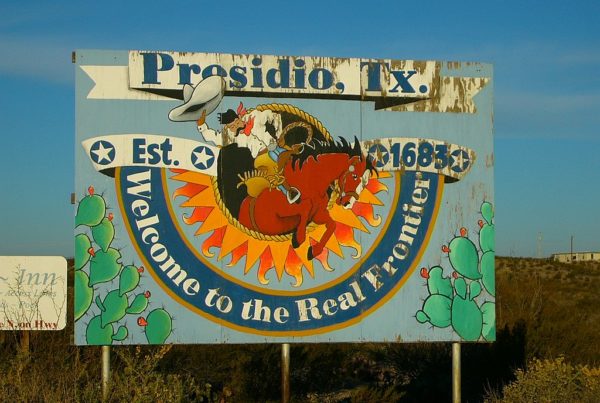From KUT:
For almost every day of Carolyn Robledo-Estrada’s 50 years of life, Metz Elementary has been a constant.
In fact, her connection to the East Austin school started before she was even born.
“Both my parents went to Metz,” she said. “I don’t know if they knew each other. I’ve had aunts and uncles that have gone to Metz, so they grew up in the neighborhood.”
Robledo-Estrada still lives in the neighborhood herself. She attended Metz as a kid, sent her own children there and for the last 17 years has been a teacher at the school.
It’s a part of her history, but at the end of this semester, the school is closing its doors for good.
A changing community
In 2019, the Austin Independent School District’s school board voted to close four schools with low enrollment, including Metz. When schools are under-enrolled, they lose money, and the district said it couldn’t afford to keep all of these campuses open. In the fall, Metz students will combine with nearby Sanchez Elementary to form a new school.
For many people like Robledo-Estrada, this school consolidation is emotional. The neighborhood around Metz used to be full of kids who attended the school. But as the city has grown, the neighborhood has changed.
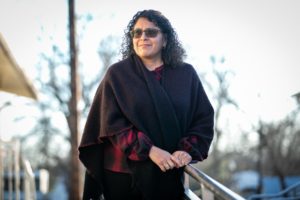
Carolyn Robledo-Estrada teaches second grade at Metz.
“When I first came here, there were lots of neighborhood kids, and now there aren’t really any neighborhood kids,” she said. “So, I feel like we lost some of that family community because it’s changed. That’s been hard.”
The neighborhood used to be populated with families who had lived there for generations, many of whom attended Metz. But over the years, the neighborhood, which is located just 2 miles from downtown, has seen home prices soar. Longtime residents are being pushed out, and many of the original homes are being bulldozed to build newer, more expensive ones.
The neighborhood used to be populated with families who had lived there for generations, many of whom attended Metz. But over the years, the neighborhood, which is located just 2 miles from downtown, has seen home prices soar. Longtime residents are being pushed out, and many of the original homes are being bulldozed to build newer, more expensive ones.
Now, Robledo-Estrada is watching the school itself disappear. She and many others in the Metz community worried: Would the role of Metz in Austin’s history be forgotten?
Thanks to a group of students at UT Austin, it won’t be.
A living archive
Last year, UT professor Elon Lang received a grant to create an experiential learning class, meaning students spend the semester working on a real-world, hands-on project. He was trying to come up with a topic, and at the time, the school closings were in the news a lot, including many community members vocalizing the historical importance of these schools. So, Lang decided to center the course around this current event.
“This class is called ‘Archival Advocacy,’” Lang said. “In it, we are trying to bring advanced undergraduate students into the process of archiving.”
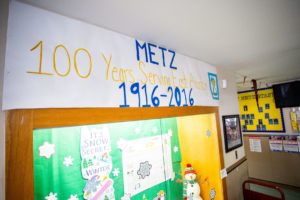
Metz celebrated its 100-year anniversary in 2016.
The seminar class had one assignment: create a digital archive about Metz. A crucial part of students’ research was working with Monica Clark, a Metz teacher who has worked there for 33 years. When Metz turned 100 a few years ago, she collected photos and made connections with alumni. The boxes from Clark’s garage got the students started.
They organized the online archive into different exhibits, featuring photo collections, timelines of the school’s history and transcripts of interviews the students did with alumni and community members. One exhibit, called “Metz in a Greater Context,” digs into the racial issues that have surrounded the school since its beginning.
They organized the online archive into different exhibits, featuring photo collections, timelines of the school’s history and transcripts of interviews the students did with alumni and community members. One exhibit, called “Metz in a Greater Context,” digs into the racial issues that have surrounded the school since its beginning.
When the school opened in 1916, it mainly educated white students. The school’s small Hispanic population further decreased when Zavala Elementary was built nearby to specifically teach Mexican-American students. But after World War II, many white families left the city for the suburbs. More and more Latino students began attending Metz, and they became the majority.
In the 1980s, AISD implemented a busing system to finally comply with the Brown v. Board of Education decision that deemed racial segregation in public schools unconstitutional. The busing system took some students from West Austin, who were mostly white, and students from East Austin, who were mostly Latino and Black, and drove them to schools on opposite sides of town.
The UT students interviewed a former teacher, Lupe Ramos, about what it was like to teach at the school when white children and teachers from West Austin came to Metz, where many students spoke Spanish as their first language.
“Ramos talks of how oftentimes the transplanted teachers did not have the ability or desire to help retain the children’s first language,” the archive says. “She describes the pairing as a ‘mismatch’ and people’s lack of desire to change their own perspectives.”
There were other conflicts as well between the Metz community and the district. Another exhibit, “Broken Promises and Neglect,” recalls how the community had to fight for basic repairs.
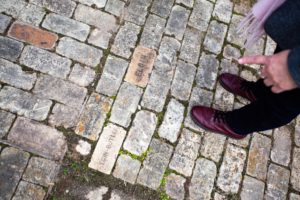
Metz Principal Azucena García points to bricks in the courtyard of the school that were used in the construction of the original building.
“In 1989, AISD announced its plan to lease a new school for a majority-white suburb,” the exhibit says. “This frustrated the Metz community because for years, Metz students had been going to school in unsafe conditions, exemplified by teacher Monica Clark’s ceiling collapsing in 1989, or the longstanding fears of the floor collapsing that led to the library being moved to the first floor.”
In the early 1990s, the district erected a new building for Metz, which is the current school building.
All of this history was brought up again in 2019 when the district proposed closing Metz. Community members said that this school had always been shoved aside and had always suffered from racist policies. What was happening now was that wealthier, white people were moving into the neighborhood but they weren’t sending their kids to the school or they didn’t have kids, which contributed to Metz’s low enrollment.
In the early 1990s, the district erected a new building for Metz, which is the current school building.
All of this history was brought up again in 2019 when the district proposed closing Metz. Community members said that this school had always been shoved aside and had always suffered from racist policies. What was happening now was that wealthier, white people were moving into the neighborhood but they weren’t sending their kids to the school or they didn’t have kids, which contributed to Metz’s low enrollment.
Despite the hard times the school community has experienced, there is also a lot to celebrate. The archive includes photos of student artwork and art around the school.
One of Lang’s favorite discoveries the UT students made was that activist and labor leader Cesar Chavez visited the school. The archive includes photos of Chavez meeting with students and an interview with local muralist Raul Valdez, who met Chavez the day he toured Metz and later painted a mural in the school about that day.
“You can see how that impacted students if you look at the archival record,” Lang said. “Even in Raul Valdez’s mural, which is painted on the ceiling in one of the common areas in the school, you have a depiction of Cesar Chavez and members of the Metz community coming together.”

A ceiling mural featuring Cesar Chavez.
‘I hope it’s remembered’
When Metz turned 100 a few years ago, Clark said there was a huge celebration. When the school board voted to close Metz in 2019, she figured they would plan another gathering like that to say goodbye. Now, that can’t happen because of the COVID-19 pandemic.
“We felt like we missed out on a chance to end our time together in a positive and in a really meaningful way,” Clark said.
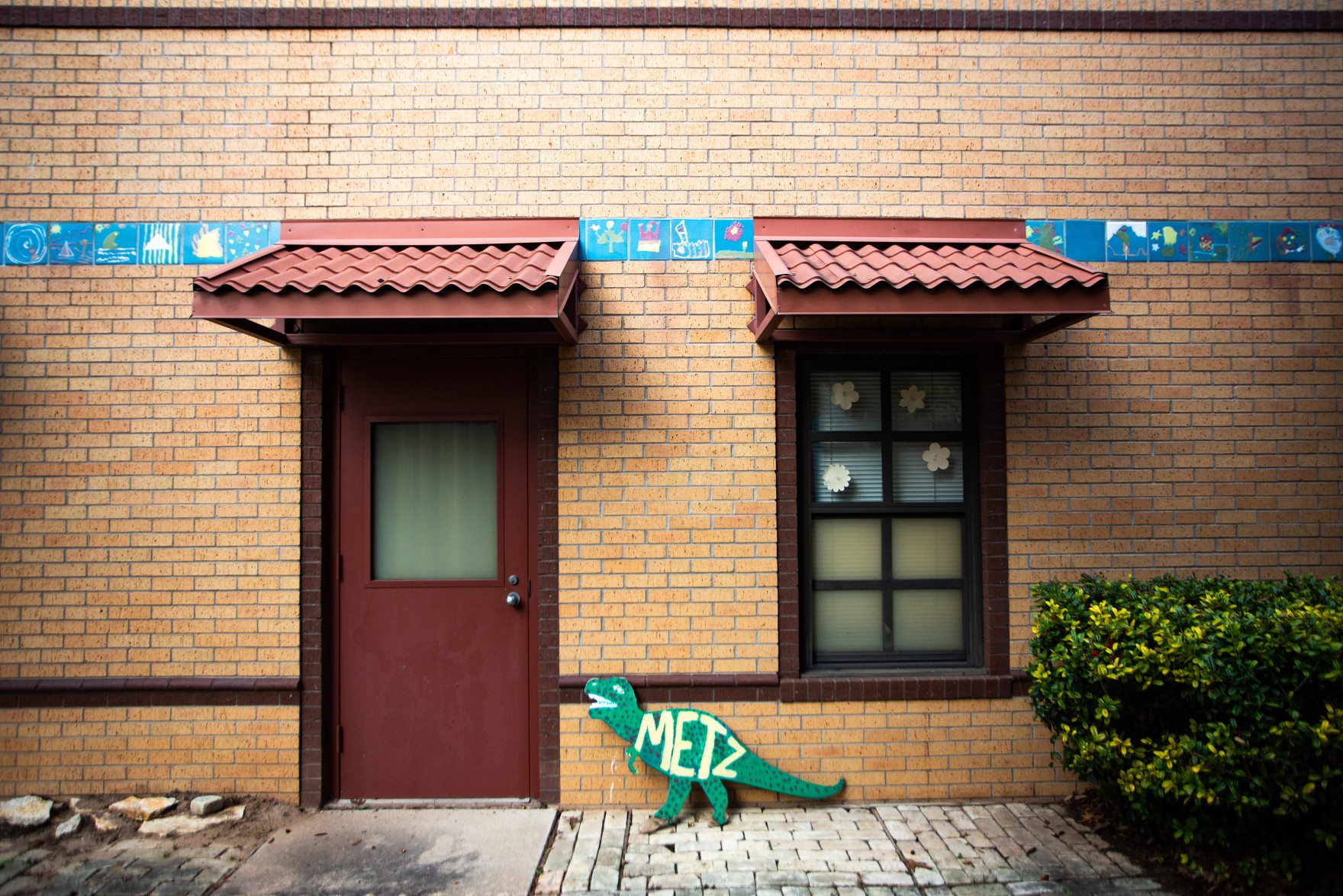
Students painted tiles that line the outside of the school.
She said she is thankful the digital archive provides some way for the community to remember the school that has meant so much to her.
The students and Lang set up the online archive so that it can constantly be updated. Members of the Metz community can add their photos and memories to the website and build upon what the students started.
That’s important to Robledo-Estrada, who says this school has changed the lives of so many people in Austin.
“I hope it is remembered,” Robledo-Estrada said. “I hope they really think about what they’re going to do with this building. I’m hoping they don’t knock it down and turn it into housing. I mean this was built for the Hispanic community [and] minority students. It’s been great for the kids that have been here all these years.”
Got a tip? Email Claire McInerny at claire@kut.org. Follow her on Twitter @ClaireMcInerny.








